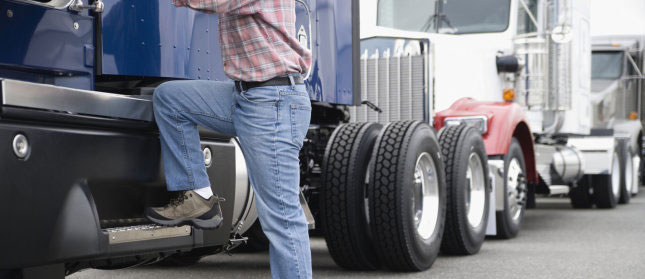
A seemingly innocuous spin behind the wheel of a U-Haul 22 years ago completely rerouted the life of Brett Aquila, then a 21-year-old warehouse employee living near Atlanta.
He’d found his calling as a truck driver.
“They needed someone to jump in a little U-Haul truck and haul a load of freight downtown and back,” Aquila says. “Boom. That was it. I went home that day, and I called J.B. Hunt and I said, ‘How much do truck drivers get paid?’ And they said, ‘About $700 a week.’ I said, ‘Holy crap, I’m making about $225.’ And about two weeks later I was in school.”
Aquila stumbled upon a profession that literally moves the domestic economy forward. The trucking industry carried nearly 10 billion tons of freight in 2014 – more than two-thirds of all products transported within the U.S., according to American Trucking Associations, a national trade group. And the sheer size of freight being carried around the country is expected to expand nearly 29 percent by 2026. Though truck drivers’ jobs can be far from glamorous, they play a fundamental role in getting America’s goods where they needs to go.
“Even when the economy died at the end of 2008 and going into 2009, trucking companies were still hiring,” Aquila says. “I had a friend that started the second week of January 2009 – the dead of winter, right after the holidays in the slowest season, when the market was at the bottom and the economy was stopped. And he came out of truck driving school and had half a dozen job offers.”
As long as goods are being bought or sold in the U.S., effective transportation systems will be a necessity. And since the vast majority of domestic freight still spends at least some time aboard a trucking rig, drivers have typically been in high demand. The supply, however, isn’t keeping pace. Though the Labor Department most recently estimated the U.S. held more than 1.6 million heavy and tractor-trailer truck drivers, that number is still shy of the industry’s 1.7 million peak in 2007.
Now, considering the amount of freight being transported across the country ballooned more than 15 percent between May 2007 and May 2015, America’s trucking fleets are being forced to move more product with less manpower. And as the industry faces problems ranging from recruitment to static pay rates, some are eyeing better technology as at least a partial fix.
“We’re short 35,000 to 40,000 [drivers] as of 2014. I haven’t quantified it yet, but I would not be surprised if that’s going to average 50,000 or more this year,” says Bob Costello, chief economist at American Trucking Associations. “There’s several factors for the driver shortage, which is a pain, because that means there’s no one solution.”
Costello says one of the industry’s problems is attracting young drivers. The median age of all American workers last year was 42.3 years old. For truck transportation employees, it was 47.
“Right now, it’s not really cool, fun or sexy to be a truck driver,” says Tony McGee, CEO and founder of HNM Global Logistics, an Orlando-based transportation logistics firm. “You don’t have kids that are wired in technology that want to do that.”
Read the full article from USNews here.

